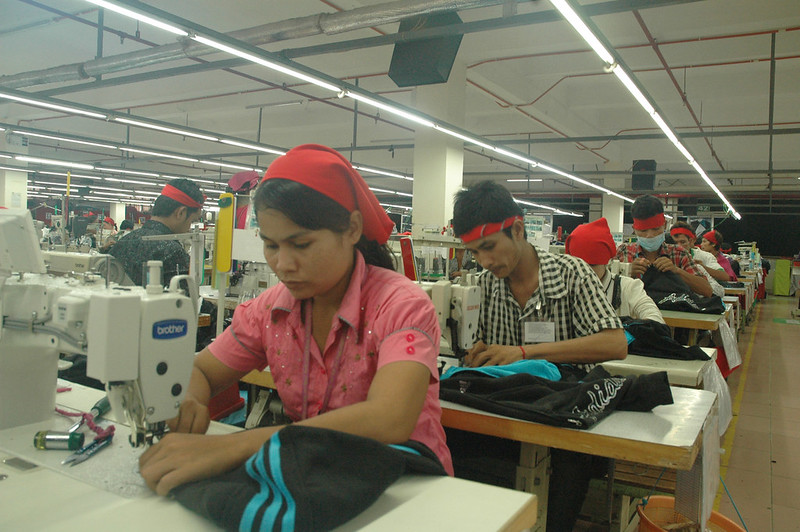Cambodia’s GFT Sector Sees Wage Increase
 Since the 1990s Cambodia’s exports from the garment, footwear and travel (GFT) sector has grown significantly. Keeping labor costs low and the intensive nature of the industry have fueled the growth of this industry, as well as the signing of international trade agreements and presence of good investment conditions.
Since the 1990s Cambodia’s exports from the garment, footwear and travel (GFT) sector has grown significantly. Keeping labor costs low and the intensive nature of the industry have fueled the growth of this industry, as well as the signing of international trade agreements and presence of good investment conditions.
Cambodia’s GFT
In 2017, Cambodia became the world’s ninth largest producer of apparel and this accounted for 1.5% of worlds export value. In 2022, the GFT industry accounted for 56.1% of Cambodia’s total export of $22.48 billion, according to Textile Today.
Cambodia’s exported products had a 14.9% increase from 2021-2022 alone. The GFT (Garment, Footwear and Travel) sector was also crucial for Cambodia’s economy during the pandemic. “The sector accounted for 11% of the economy and contributed to half of Cambodia’s real GDP growth,” although the country was not operating at full capacity, the GFT sector was still functioning relatively well.
The garment worker industry consists of 1,188 factories and employs around 750,000 workers, most of whom are women. Around 76% of the female population work in the GFT sector which serves to stand as the backbone of the Cambodian economy.
Despite being one of the main drivers of the Cambodian economy, the GFT sector faces challenges when it comes to long-term sustainability, the sector is currently reliant on preferential market access granted by the U.S. and the EU which makes it susceptible to the withdrawal of the trade agreements.
New Plan
In September 2024, Cambodia increased the minimum wage in the GFT sector to $208 per month, an increase of $4. The plan has received both negative criticism and praise but ultimately lies in favor of the workers which is a step in the right direction. The decision follows discussions by the National Council for Minimum Wage, which initially proposed the wage be set at $206, however, Prime Minister Hun Manet, raised the figure an additional $2, in an ongoing effort to improve worker living standards.
In addition to the minimum wage increase, workers will also receive benefits like a $10 monthly bonus for regular work attendance and an extra $7 to aid with transport and rent. These benefits will help workers manage their daily living expenses alongside their base wages.
Cambodia, like many other countries, faces pressure to make sure that workers receive compensation without undermining the competitive nature of the GFT manufacturing sector. This approach by the government aims to ensure a balance between the workers’ needs and the industry’s sustainability.
Reception of the New Plan
Labor groups have acknowledged the rise in wages, however, have also addressed that the increase may not fully address the cost of living in many urban areas, where many workers reside. Industry leaders have also raised questions and concerns about the impact on production costs as the GFT sector remains competitive, both economically and production-wise, according to the Cambodia Investment Review.
Kim Chansamnang, a representative of the union stated that the workers are “satisfied with the increase”, however, he also urged the landlords not to raise rent prices and added that “the minimum wage has not risen significantly,” Khmer Times reports.
According to Prime Minister Manet, the government focuses on improving the living standards of the people, he also stated that he would “urge relevant ministries and authorities to monitor and implement measures to reduce worker costs”
Sin Sovan, of the Russey Keo district, said that she accepts the new figures but also appeals to markets and landlords to not increase prices of food. She also acknowledged that this was the government’s intervention and appeal to prevent raised rents and to keep food prices stable, according to Khmer Times.
The Future of Cambodia’s GFT
The recent minimum wage increase in Cambodia’s GFT sector marks another step in the right direction for the workers. It holds a significant place in the government’s plan to improve the livelihoods of workers in general, particularly those in the GFT (garment, footwear and travel) sectors. The raise provides relief to the workers, however, some concerns remain regarding the cost of living. Employers must now navigate survival in the competitive nature of the market alongside higher labor costs.
Cambodia continues to develop its economy and so a balance between worker satisfaction and business sustainability. The government, employers and workers must continue to work together and hold discussions to ensure that future wage policies are fair for all. Additional measures such as social protection and improved worker training could also complement the wage increase and contribute to long-term economic stability for the country.
– Ayat Aslam
Ayat is based in London, UK and focuses on Good News and Global Health for The Borgen Project.
Photo: Flickr
